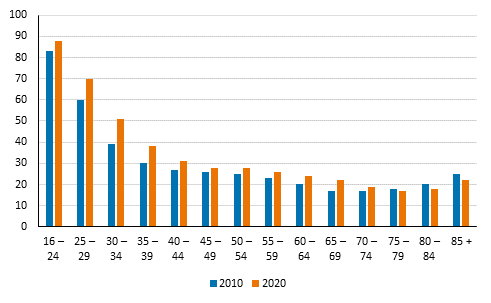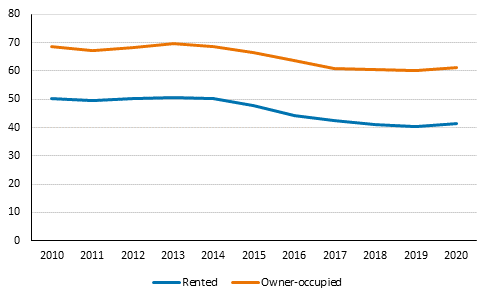Published: 14 October 2021
Three out of five persons aged under 40 live in rented dwellings
Living in rented dwellings has increased during the 2010s. According to Statistics Finland, living in rented dwellings has increased most among household-dwelling units of persons under the age of 40, but the share of those living in rented dwellings has also increased among household-dwelling units aged between 40 and 74. At the end of 2020, altogether 34 per cent of all household-dwelling units lived in rented dwellings, which is four percentage points more than in 2010.
Household-dwelling units living in rented dwellings by the age of the oldest member in 2010 and 2020, share of household-dwelling units in the same age group (%).

In 2020, a total of 61 per cent of the household-dwelling units aged under 40 in Finland lived in rented dwellings, while the share was 52 per cent in 2010. Rental living has grown most among household-dwelling units in the 25 to 29 and 30 to 34 age groups, where the share of renting household-dwelling units increased by around 10 percentage points. During the 2010s, the share of those living in rented dwellings decreased only among people aged 75 or over.
For young people living independently, rental living is clearly more common than owner-occupancy; nearly 90 per cent of household-dwelling units of under 25-year-olds live in rented dwellings. Young people move more often than others, and as life situations change, living in rented dwellings is more flexible than owner-occupancy. Living in rented dwellings is more common among young people in urban municipalities, where 89 per cent of household-dwelling units of persons under the age of 25 live in rented dwellings. In rural municipalities the share is 67 per cent.
Rental living becomes rarer with age, around one in four household-dwelling units of persons over the age of 40 lived in rented dwellings at the end of 2020.
Average size of new dwellings in blocks of flats has decreased in ten years
The average size of new dwellings in blocks of flats has decreased during the 2010s especially as concerns rented dwellings. Rented dwellings completed in blocks of flats in 2020 are an average of nine square metres smaller than those completed in 2010. Over the same period, the average floor area of owner-occupied dwellings built in blocks of flats has decreased by around seven square metres. The comparison takes into account occupied dwellings in blocks of flats.
In 2020, dwellings completed in blocks of flats were slightly larger than those completed in the year before. The average floor area of new rented and owner-occupied dwellings started to grow for the first time since 2013.
Average floor areas of occupied rented and owner-occupied dwellings completed in blocks of flats in Finland by year of completion, square metres.

The decrease in the average size of dwellings in blocks of flats during the 2010s is not solely explained by the grown production volumes of smaller types of dwellings, because floor areas by type of dwelling have also decreased. For example, occupied rented 2-bedroom dwellings completed in blocks of flats in 2020 are, on average, nearly six square metres smaller than those completed in 2010.
The size difference between new owner-occupied and rented dwellings has grown in ten years. Owner-occupied dwellings completed in blocks of flats in 2020 are nearly 20 square metres larger than rented dwellings, while the difference for dwellings built in 2010 is around 18 square metres.
The average floor area of new rented dwellings has diminished more in the six biggest towns than elsewhere in Finland. In the biggest towns, occupied rented dwellings in blocks of flats completed in 2020 are, on average, nearly 10 square metres smaller than those completed in 2010, while in the rest of Finland the average size has decreased by slightly over seven square metres.
Source: Dwellings and Housing Conditions, Statistics Finland
Inquiries: Mika Ronkainen 029 551 3425, Anu Rämö 029 551 3450, info@stat.fi
Head of Department in charge: Hannele Orjala
Publication in pdf-format (353.5 kB)
- Reviews
-
- 1. Dwelling stock 2020 (14.10.2021)
- 2. Household-dwelling units and housing conditions 2020 (14.10.2021)
- Tables
-
Tables in databases
Pick the data you need into tables, view the data as graphs, or download the data for your use.
Appendix tables
- Appendix table 1. Household-dwelling units by number of persons in 1960 - 2020 (14.10.2021)
- Appendix table 2. Household-dwelling units by housing density on 31 Dec. 2020, by region (14.10.2021)
- Appendix table 3. Household-dwelling units and persons by tenure status in 1970 - 2020 (14.10.2021)
- Appendix table 4. Average floor area (m2) of dwellings in the dwelling stock in 1970 - 2020 (14.10.2021)
- Appendix table 5. Dwelling stock and amenities in 1960 - 2020 (14.10.2021)
- Appendix table 6. 20 - 29-year-old residential population by family status and tenure 2005 - 2020 (14.10.2021)
Updated 14.10.2021
Official Statistics of Finland (OSF):
Dwellings and housing conditions [e-publication].
ISSN=1798-6761. Overview 2020. Helsinki: Statistics Finland [referred: 25.12.2025].
Access method: http://stat.fi/til/asas/2020/01/asas_2020_01_2021-10-14_tie_002_en.html

